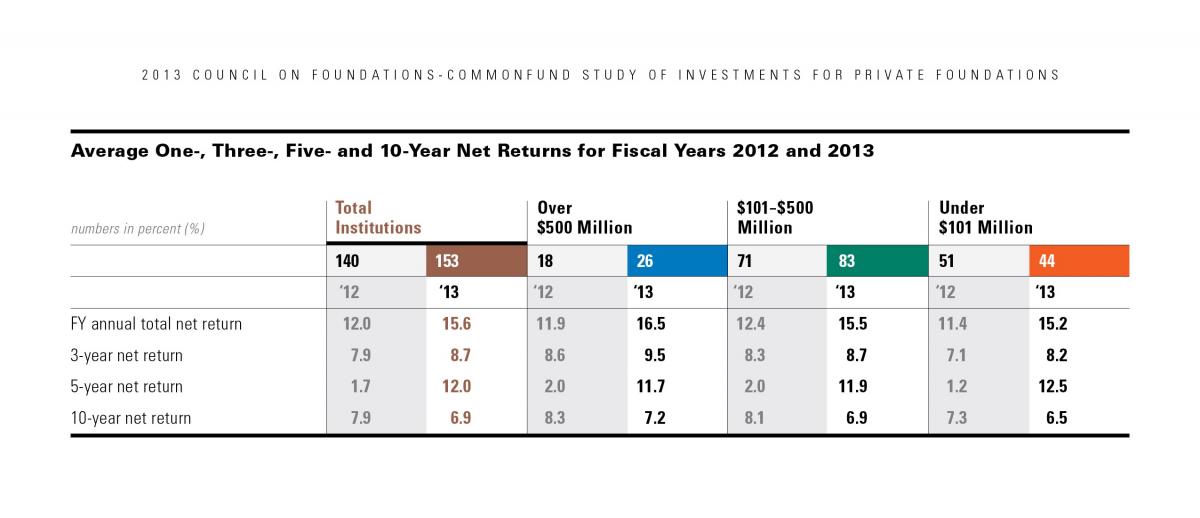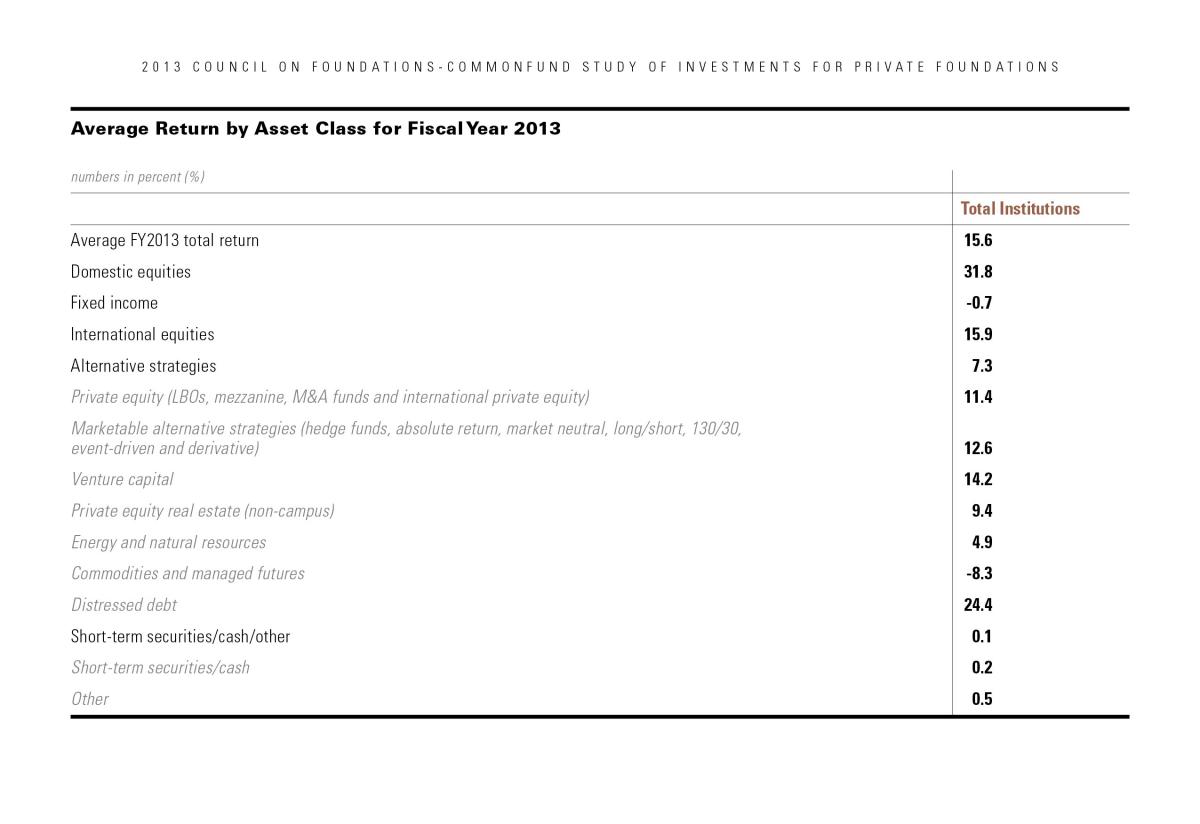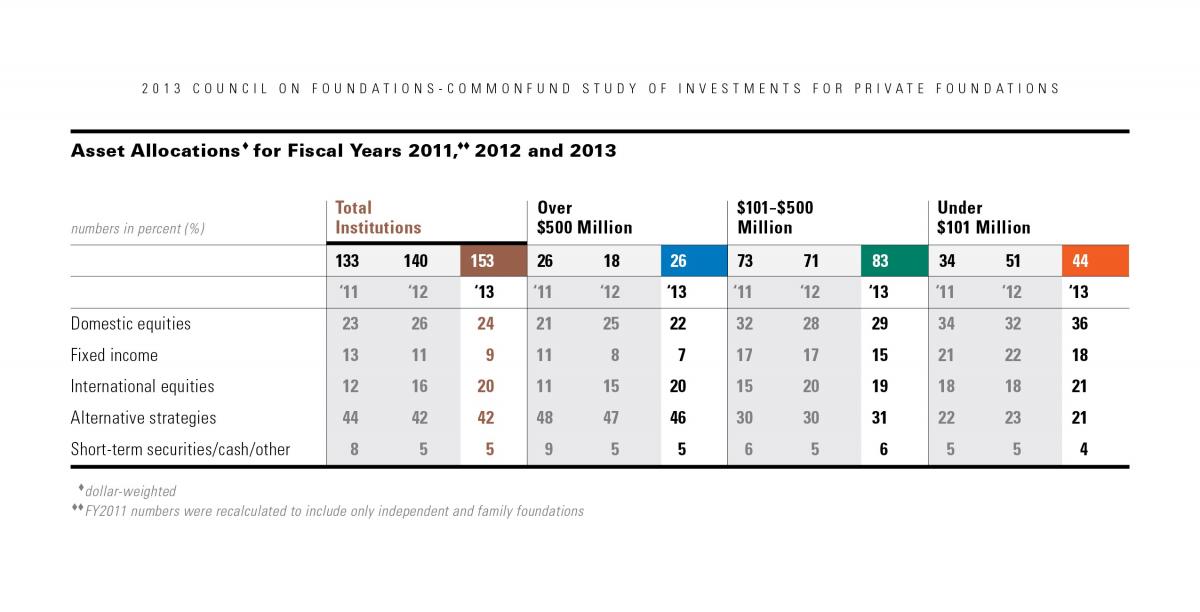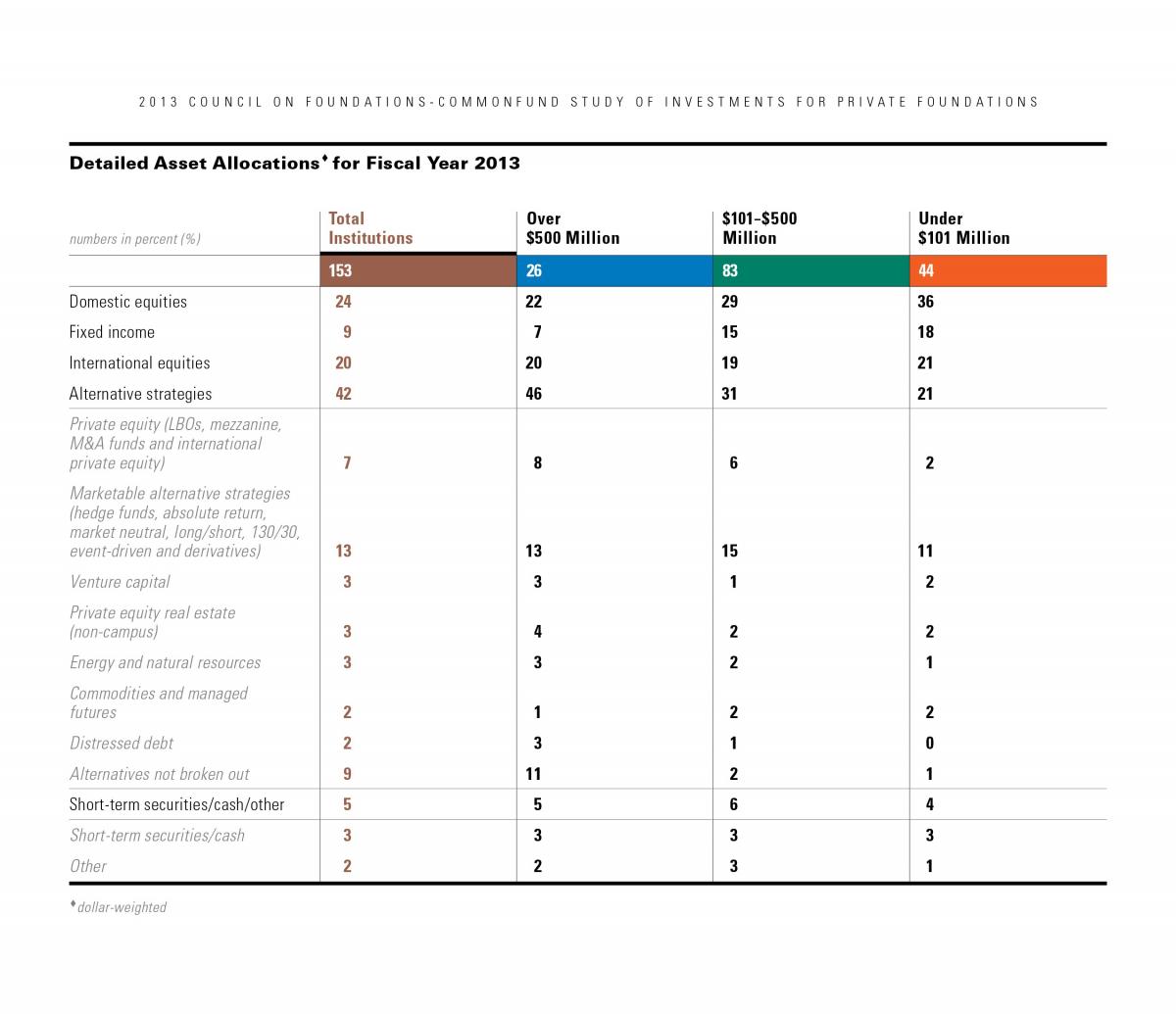Private Foundations' Fiscal Year 2013 Investment Returns Build on FY2012 Gains
Council on Foundations-Commonfund Study Reports a Strong Year for Foundation Investments; Allows Assets to Rebound from Recession
Investment returns at private foundations rose to an average of 15.6 percent in 2013 – the second-straight year of double-digit average returns – according to the 2013 Council on Foundations-Commonfund Study of Investments for Private FoundationsTM (CCSF). Reporting data from 153 private foundations with assets of $94.1 billion, the CCSF is the most comprehensive annual survey of its kind by two leading authorities on foundation investment and governance policies and practices.
When viewed by size of participating foundation, the CCSF return data show the highest return, at 16.5 percent, came from organizations with assets over $500 million. Foundations with assets between $101 and $500 million realized an average return of 15.5 percent, while foundations with assets under $101 million reported an average return of 15.2 percent. (All returns are net of fees.)
Looking at multi-year results, the 2013 Study shows that trailing three-year returns for participating foundations averaged 8.7 percent compared to 2012’s 7.9 percent. Trailing five-year returns jumped to 12.0 percent from 1.7 percent, as the poor return of 2008 (-25.9 percent) dropped out of the five-year calculation. For the trailing 10-year period, returns averaged 6.9 percent compared with last year’s 7.9 percent. The Study also showed, now that markets have recovered, foundations are increasing their return targets again, albeit cautiously, as they continue to rebound from the negative financial effects of the Great Recession.

In a joint statement, Vikki Spruill, President and CEO of the Council on Foundations, and John S. Griswold, Executive Director of Commonfund Institute, said, “This report contains good news for the country. With double-digit returns for the second year in a row, private foundations have regained solid financial footing positioning them well for community investment.”
Spruill and Griswold noted that an average of 56 percent of participating foundations reported an increase in mission-related spending -- up from 47 percent a year ago. At the same time, only 26 percent reported a decrease -- down from last year’s 32 percent. “As communities continue to recover, they look to government, businesses, and the philanthropic sector to help them find solutions. As foundation assets continue to rebound, they have more resources to invest in programs that advance the common good.”
Among investment returns from specific asset classes and strategies in FY2013, domestic equities produced the highest by far—an average of 31.8 percent, double the 15.9 percent return reported for investments in international equities. Alternative strategies generated a return of 7.3 percent, while short-term securities/cash/other returned 0.1 percent. Fixed income produced a negative return in FY2013 of -0.7 percent, as the gradual withdrawal of market support by central banks caused historically low interest rates to rise and bond prices to fall.
Within the broad category of alternative strategies, distressed debt produced the highest return for the second consecutive year, at 24.4 percent. Venture capital returned 14.2 percent, marketable alternative strategies (hedge funds, absolute return, market neutral, long/short, 130/30, event driven and derivatives) reported a 12.6 percent advance, and private equity (LBOs, mezzanine, M&A funds and international private equity) returned 11.4 percent. Private equity real estate (non-campus) returned 9.4 percent and energy and natural resources returned 4.9 percent. Commodities and managed futures produced a negative return for the year, at -8.3 percent.
Additional information about private foundation investment performance, asset allocation, governance and related topics follows.

Asset Allocation
On December 31, 2013, participating institutions’ asset allocations (with comparable FY2012 allocations in parentheses) were:
- Domestic equities: 24 percent (26 percent)
- Fixed income: 9 percent (11 percent)
- International equities: 20 percent (16 percent)
- Alternative strategies: 42 percent (42 percent)
- Short-term securities/cash/other: 5 percent (5 percent)


Spending
The effective spending rate among participating foundations—derived by dividing the amount spent on mission by the market value of the foundation at the beginning of the year—rose slightly to 5.5 percent in FY2013 from 5.4 percent in FY2012, returning the effective spending rate to the 5.5 percent level reported in FY2011.
When the data are viewed by foundation size, foundations with assets over $500 million had the lowest effective spending rate, at 5.2 percent, while those with assets between $101 and $500 million had the highest effective spending rate, at 5.7 percent. Organizations with assets under $101 million reported an effective spending rate of 5.3 percent.
Among all participating foundations, 36 percent reported an increase in their effective spending rate, 43 percent reported a decrease and 16 percent reported no change. (Five percent gave no answer or were uncertain.)
Spending in dollar terms continued to increase on average, with 56 percent reporting increased dollar spending in FY2013 while 26 percent reported a decrease. Nine percent each reported no change, did not answer or were uncertain. In last year’s CCSF, 47 percent reported increasing spending in dollars while 32 percent reported decreasing it and 15 percent reported no change.
Debt
Continuing the deleveraging trend of recent years, for FY2013 the 12 foundations reporting that they carried debt had an average debt of level of $42.4 million versus $46.5 million a year ago and $54.1 million in FY2011. Median debt also fell, reaching an average of $11.1 million in FY2013, down from $14.6 million in FY2012 and $14.0 million in FY2011.
Resources, Management and Governance
The number of full-time professional private foundation staff devoted to investments averaged 1.3 full-time equivalents (FTEs), a decline from last year’s average of 1.4 FTEs and 1.5 FTEs in FY2011. Twenty-five percent of Study participants reported having a chief investment officer, a figure that rose to 58 percent among the largest participating foundations with assets over $500 million. Seventy-three percent of Study participants reported using a consultant compared with 80 percent a year ago. Thirty percent of respondents said they have substantially outsourced their investment function, down from last year’s 38 percent, and back to the level reported in FY2011. Ninety-five percent of participating foundations reported that they have a conflict of interest policy.
The average number of voting members on participating foundations’ investment committees was 5.5, up from 5.4 reported for the two previous years. The average number of investment committee members who are investment professionals was 2.4, down slightly from 2.5 last year, while investment committee members with alternative strategies experience stood at 1.6, down moderately from 1.7 reported for the last two years.
Research Process and Methodology
The design of the 2013 Council on Foundations–Commonfund Study of Investments for Private Foundations (CCSF) took place in the winter of 2013. Web-enabled questionnaires and field interviews with the participating institutions followed in the first and second calendar quarters of 2014.
Online interviews were supported by extensive telephone contact, a research technique that assures greater integrity in the data gathering process. Respondents were the individuals most knowledgeable about investment matters at participating institutions.
Data from the Study’s research populations were segmented into three size categories to permit analysis of the policies and practices of foundations of differing sizes. The size categories were: institutions with assets over $500 million; institutions with assets between $101 million and $500 million; and institutions with assets under $101 million.
The second annual CCSF report will be made available to all participants. The report will also include a comprehensive written analysis setting the data in the context of the current financial environment and recent trends.
Media Contacts:
Commonfund Institute
John S. Griswold
203-563-5030
jgriswol@cfund.org
William F. Jarvis
203-563-5296
wjarvis@cfund.org
Council on Foundations
Calvin Harris
703-879-0612
calvin.harris@cof.org
Gibbs & Soell
Kyle Kuhnel
212-697-2600
kkhunel@gibbs-soell.com
About The Council on Foundations
The Council on Foundations (www.cof.org), formed in 1949, is a nonprofit membership association of grantmaking foundations and corporations. Members of the Council include nearly 1,600 independent, operating, community, public and company-sponsored foundations, and corporate giving programs in the United States and abroad. The Council’s mission is to provide the opportunity, leadership, and tools needed by philanthropic organizations to expand, enhance and sustain their ability to advance the common good.
About Commonfund
Commonfund was founded in 1971 as an independent nonprofit investment firm with a grant from the Ford Foundation. Directly or through its subsidiaries—Commonfund Capital and Commonfund Asset Management Company—Commonfund today manages nearly $25 billion for endowments, foundations and pension funds. Among the pioneers in applying the endowment model of investing to institutional investors, Commonfund provides extensive investment flexibility using independent investment sub-advisers for discretionary outsourcing engagements, single strategies and multi-asset solutions. Investment programs incorporate active and passive strategies in equities and fixed income, hedge funds, commodities and private capital. All securities are distributed through Commonfund Securities, Inc., a member of FINRA. For additional information about Commonfund, please visit www.commonfund.org.
About Commonfund Institute
Commonfund Institute houses the education and research activities of Commonfund and provides the entire community of long-term investors with investment information and professional development programs. Commonfund Institute is dedicated to the advancement of investment knowledge and the promotion of best practices in financial management. In addition to teaming with the Council on Foundations to produce the CCSF, Commonfund also produces the NACUBO-Commonfund Study of Endowments (NCSE) and the Commonfund Benchmarks Study series of research reports. Commonfund Institute also provides a wide variety of resources, including conferences, seminars and roundtables on topics such as endowments and treasury management; proprietary and third-party research and publications, including the Higher Education Price Index ® (HEPI) and Insight Online, a biannual investment magazine; and events such as the annual Commonfund Forum and Commonfund Endowment Institute. ®
###
